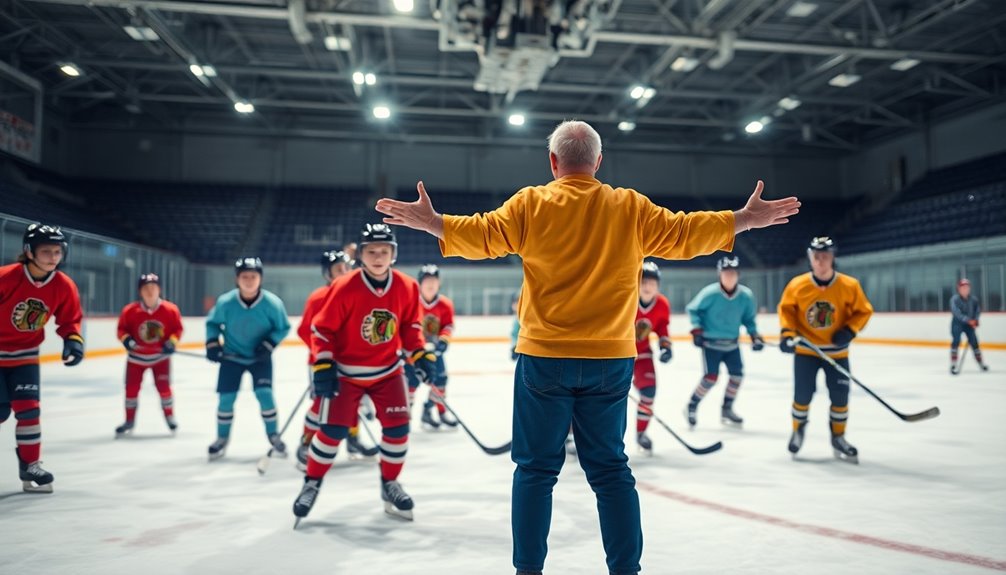
The Art of Reading and Reacting in Hockey
December 27, 2024Mastering the art of reading and reacting in hockey is essential for your on-ice performance. You need to anticipate your opponents' moves and make quick decisions. This involves keen observation of body language, puck movement, and player positioning. Effective communication with teammates enhances your situational awareness. Practicing drills that simulate game scenarios sharpens your instincts, helping you shift smoothly between offense and defense. The better you recognize patterns, the more competitive edge you'll gain. There are many strategies you can employ to enhance your skills and team dynamics, so keep exploring to reveal more insights.
Importance of Reading the Game
Why is reading the game so essential in hockey? It's critical because it allows you, as a hockey player, to anticipate opponents' movements and make quicker decisions. This skill greatly enhances your performance on the ice. Effective reading involves recognizing patterns during play, which helps you position yourself advantageously in both offensive and defensive situations. A strong sense of team coordination is also crucial for maximizing your effectiveness on the ice.
When you develop a strong sense of game awareness, you can identify high-threat areas more easily. This allows for timely interventions or scoring opportunities that can change the outcome of a game. Understanding key regulations can also provide players with insights that enhance their ability to read the game effectively.
Communication with your teammates also plays an important role in reading the game. When you talk and share insights on the ice, it fosters a more cohesive and responsive team dynamic.
Additionally, engaging in regular practice through drills designed to boost situational awareness can elevate your hockey sense. This focus on enhancing your ability to read the game makes you more effective in live play scenarios. Furthermore, consistent effort in practice is crucial for refining skills that improve game awareness.
Developing Hockey Sense
Enhancing your hockey sense is essential for elevating your performance on the ice. To develop this important skill, you need to improve your ability to read the play and make quick decisions. Start by participating in drills that simulate game scenarios. These exercises will help you assess the ice and recognize threats in real-time, sharpening your instincts during actual games. Regular training is crucial for adapting to various game situations, just as it is in soccer. Incorporating quality training sessions into your routine will further enhance your ability to make split-second decisions.
Effective communication with your teammates also plays a significant role in developing hockey sense. By understanding each other's roles and responsibilities, you can react more effectively in fast-paced situations.
Additionally, analyzing video footage of your games can be tremendously beneficial. It allows you to identify patterns and improve your predictive abilities, which are key components of hockey sense.
Coaches should guide you in recognizing high-threat areas on the ice. When you can pinpoint these zones, you'll be better equipped to make smarter decisions and support your teammates. Furthermore, mastering step-over skills in soccer can enhance your overall agility and reaction time on the ice, contributing to better performance in hockey.
Anticipating Opponents' Moves

To anticipate your opponents' moves, pay close attention to their body language and puck movement patterns. These cues can give you valuable insights into their next actions, allowing you to react more swiftly during the game. Practicing this skill consistently will sharpen your instincts and improve your overall performance on the ice. Additionally, developing peripheral awareness can enhance your ability to spot threats and adjust your positioning effectively. Incorporating agility and coordination workouts into your training can further enhance your responsiveness on the ice. Furthermore, understanding defensive stance drills can provide a solid foundation for improving your positioning and quick reactions when anticipating plays.
Body Language Cues
Mastering the art of reading body language can give you a notable edge on the ice. Recognizing the body language importance of your opponents can enhance your anticipation skills immensely.
Pay close attention to movement indicators like the direction of their shoulders and hips; these often reveal their intended movements. A slight shift in an opponent's weight can signal a change in direction, allowing you to adjust your positioning accordingly.
The positioning of their stick is another vital aspect. A raised stick might indicate a shot or pass, while a low stick suggests they're preparing to protect the puck. By observing these opponent signals, you can predict their next move more accurately.
Don't overlook eye movement either; if an opponent is looking in a specific direction, it usually foreshadows their next play. This makes it essential for you to focus on their gaze to stay one step ahead.
Puck Movement Patterns
Often, players who can quickly read puck movement patterns gain a considerable advantage during a game. By honing your puck trajectory analysis skills, you'll better anticipate your opponents' next moves.
Develop a keen sense of timing and spatial awareness, as these are essential for effective reactions. Understanding "inside leverage" helps you position yourself most effectively to intercept passes and disrupt the opponent's flow.
Incorporate defensive positioning techniques in your practice to improve your ability to read plays. Focus on predicting the puck carrier's next move based on their body language and stick position.
Effective communication with teammates can also enhance your anticipation of puck movement. Verbal cues allow you to adjust your positioning, creating scoring opportunities or solid defensive coverage.
Additionally, analyzing game footage to identify common puck movement patterns can greatly enhance your decision-making on the ice. This understanding allows you to implement offensive zone strategies that exploit your opponents' weaknesses while bolstering your defensive play.
Anticipation Through Practice
Anticipation is a critical skill that can set you apart in hockey, and honing it through practice is essential. Regular situational drills, like shifting from 1v1 to 2v2, boost your ability to read play dynamics and anticipate opponents' moves. By focusing on tactical awareness during these drills, you'll improve your spatial positioning on the ice, allowing you to better predict where the puck might go.
Incorporating verbal communication in practice is key. When you and your teammates share insights about your positions and intentions, it fosters a collective anticipation of the opponent's actions. Coaches should emphasize identifying high-threat areas on the ice, helping you recognize where to focus your attention.
Additionally, practicing role changes between offense and defense sharpens your instincts, enabling you to predict opponents' strategies based on their movements.
Finally, video review sessions provide invaluable insights into common patterns and tendencies exhibited by opponents, enhancing your anticipation skills in real-time play. By consistently applying these adaptive strategies, you'll not only elevate your performance but also contribute to a more cohesive team effort on the ice.
Quick Decision-Making Skills
In hockey, quick decision-making skills can make the difference between winning and losing. You need to anticipate your opponent's movements, recognize plays instinctively, and communicate effectively with your teammates. Additionally, fan support plays a crucial role in boosting team morale, which can translate to better on-ice performance. Furthermore, the inspiration for future generations of athletes can enhance the competitive spirit and camaraderie within the sport. The foundation of success in hockey is built upon teamwork and unity, which fosters a supportive environment where every player feels valued.
Anticipating Opponent Movements
Players regularly find themselves in situations where anticipating opponent movements can make or break a play. Developing a keen sense of situational awareness is vital; you need to read body language and predict play patterns effectively.
Successful players employ defensive positioning strategies, utilizing techniques like "inside leverage" and agile footwork to gain an advantage. This positioning allows for quicker reactions when the game speeds up.
Your ability to change speed and direction can create offensive opportunities while also helping you defend against fast opponents. Practicing drills that mimic real-game scenarios, such as shifting from 1v1 to 2v2, enhances your instincts and decision-making skills in dynamic situations on the ice.
Additionally, verbal communication with teammates is essential. It allows you to recognize roles and support each other's movements, ensuring everyone reacts promptly to the opponent's strategies.
Instinctual Play Recognition
Reading the flow of the game doesn't stop at anticipating opponent movements; it extends into recognizing plays as they unfold. Instinctual play recognition is essential for making quick decisions that can turn the tide of a game.
As you develop your cognitive skill set, you'll find that effective players can assess play dynamics by closely observing player positioning and puck movement. This ability to read the game allows you to respond with agility, whether on offense or defense.
When shifting from offense to defense, quick decision-making becomes critical. You need to rapidly adjust your role based on the game's flow.
Training drills that simulate live scenarios, like 1v1 or 2v2 situations, are excellent play recognition techniques that hone your ability to think on your feet. These drills enable you to practice instinctual decision making under pressure, ensuring you're ready when it matters most.
Effective Communication Techniques
Effective communication on the ice can be the difference between a seamless play and a missed opportunity. You need to prioritize verbal clarity, using concise terminology to quickly share crucial information about puck location, player positioning, and potential threats. This not only heightens your situational awareness but also guarantees your teammates know their roles in dynamic situations.
Signal consistency is equally important. Hand gestures and body positioning can enhance non-verbal communication, allowing you and your teammates to anticipate each other's actions without relying solely on spoken cues. By incorporating these methods, you can create a more synchronized team environment.
Regularly practicing communication drills is essential. These drills help you develop instinctive responses under pressure, enabling quicker decision-making during games.
Coaches should emphasize maintaining an open line of communication at all times. This encourages team cohesion and increases the likelihood of successful plays and effective defensive coverage.
Role Recognition on the Ice

Understanding your role on the ice is essential for contributing to your team's success in various game situations. When you grasp role clarity, you enhance your positional awareness and can make dynamic adjustments as the game unfolds. Recognizing your responsibilities allows you to react effectively and support your teammates.
Here are key aspects to keep in mind:
- Identify your primary responsibilities, whether you're a forward or defenseman.
- Communicate with teammates during shifts to guarantee everyone knows their roles.
- Anticipate high-threat areas and adjust your positioning to defend against opposing plays.
- As a puck carrier, decide quickly whether to attack or hold the play for support.
- Be prepared for quick role changes, shifting from offense to defense seamlessly.
- Understanding the importance of teamwork and collaboration can significantly enhance your synergy on the ice. Additionally, fostering a strong fan base can create a supportive environment that boosts team morale.
- The evolution of team sports like soccer emphasizes the importance of team dynamics in fostering effective communication and cooperation among players.
When you maintain a clear understanding of your role, you not only improve your individual performance but also enhance the overall dynamics of your team.
Emphasizing role recognition fosters a cohesive unit that can react swiftly to the ever-changing landscape of the game. So, stay aware, adjust dynamically, and contribute effectively to your team's success.
Effective Communication Strategies
Clear communication is essential for success on the ice, as it guarantees timely support and enhances teamwork in fast-paced situations. To overcome communication barriers, you must prioritize verbal clarity. Use specific terminology to articulate your roles and actions, which helps everyone understand their responsibilities without confusion. This clarity minimizes mistakes and keeps the game flowing smoothly.
Consistency in your cues is vital. When signaling intentions—whether by voice or through non-verbal methods like hand signals and body positioning—maintain a standard that your teammates can rely on. This consistency builds a rhythm that fosters better coordination during intense moments.
Additionally, reviewing game footage as a team can illuminate areas for improvement in your communication strategies. By evaluating your effectiveness, you can identify what works and what needs adjustment.
Lastly, establishing a culture of open communication fosters trust among players. When you feel confident expressing yourself, your decision-making improves, allowing you to react instinctively during high-pressure situations.
Embrace these communication strategies to elevate your game and guarantee your team operates as a cohesive unit on the ice.
Supporting Teammates in Play

Support is the backbone of successful hockey play, enabling teams to execute strategies effectively. When you focus on supporting your teammates, it enhances your situational awareness and improves play recognition.
By understanding your teammates' tendencies and positions, you can anticipate their movements and provide timely support, whether during an offensive attack or defensive stand. Here are some key aspects to evaluate:
- Consistently call for the puck and provide clear instructions to your teammates.
- Recognize high-threat areas on the ice to know when to support puck carriers.
- Quickly adapt to role changes, shifting from offensive support to defensive coverage as needed.
- Engage in drills that promote situational awareness to enhance your reading of plays.
- Cultivate an understanding of your teammates' play styles to build effective chemistry.
Transitioning Between Offense and Defense
When you're on the ice, recognizing your role during a shift is essential for maintaining team structure.
Communication with your teammates helps guarantee everyone knows their responsibilities, making it easier to move from offense to defense.
Role Recognition Importance
Effective role recognition is essential for players as they shift between offense and defense in hockey. When you understand your responsibilities during these shifts, you enhance team coordination and performance. Quick assessments of the on-ice situation enable you to determine when to switch from attacking to supporting roles, which ultimately boosts your chances of maintaining puck possession and creating scoring opportunities.
Here are some key aspects to reflect on for effective role recognition:
- Role clarity benefits: Knowing your specific responsibilities helps prevent confusion during fast-paced shifts.
- Shift strategies: Develop strategies that allow for seamless movements between offensive and defensive postures.
- Player accountability: When each player knows their role, accountability increases, leading to better team dynamics.
- Anticipate high-threat areas: Recognize potential danger zones to react swiftly and effectively during sudden changes.
- Read the play away from the puck: Understanding the flow of the game enhances your overall game strategy and optimizes team performance.
Effective Communication Strategies
Understanding your role on the ice is just the beginning; communicating effectively with your teammates takes that awareness to the next level. As you shift between offense and defense, make certain there's strong team strategy alignment. This involves recognizing each player's responsibilities and utilizing established communication styles that suit your team's dynamics.
Verbal cues effectiveness is essential during these shifts. By setting clear signals, you can alert your teammates to imminent changes in play, enhancing quick decision-making. When you're aware of high-threat areas on the ice, it's important to communicate this to support puck carriers and defend against opponents effectively.
Timely support and collaboration during shifts can greatly boost your team's performance. Anticipating plays becomes easier when everyone's on the same page, allowing for swift reactions.
Encourage open dialogue during drills, as this reinforces the importance of maintaining situational awareness.
Drills to Enhance Reactivity

Drills designed to enhance reactivity play an essential role in developing players' decision-making skills on the ice. Incorporating live drills can greatly boost your ability to read the game, especially when shifting from 1v1 to 2v2 scenarios.
Here are some effective strategies to implement:
- Set up two nets cross-ice using foam dividers to create distinct lanes.
- Encourage players to recognize their roles as they enter the zone and adapt to changing situations.
- Promote verbal cues during drills to enhance teamwork and situational awareness.
- Teach timely support for puck carriers, focusing on when to attack or hold back for teammates.
- Utilize coaching points that emphasize role recognition and effective zone entry for defenders.
Mental Aspects of Performance
While physical skills are essential in hockey, the mental aspects of performance can be just as important in determining a player's success on the ice. Developing effective self-talk strategies is key; a positive internal dialogue can greatly enhance your confidence and overall performance during games and practices.
By setting clear goals and visualizing successful plays, you can maintain focus and improve your decision-making in fast-paced situations.
Creating emotional safety within your team environment is equally important. When you feel secure enough to express yourself freely, it fosters better communication and collaboration among teammates.
Structured feedback mechanisms are critical too; they help you recognize areas for improvement while reinforcing your strengths, allowing you to grow as a player.
Don't underestimate the impact of parental influence on your development. Supportive parents can boost your motivation and enjoyment of the game, contributing to a positive hockey experience.
Building Team Dynamics

Building strong team dynamics is essential for a successful hockey season, as effective communication among players guarantees everyone knows their roles on the ice.
When players can read and react to each other seamlessly, it creates a fluidity that enhances overall performance.
To achieve this, focus on the following strategies:
- Engage in team bonding activities to strengthen relationships.
- Participate in trust building exercises that foster confidence among teammates.
- Schedule regular off-ice teamwork sessions to develop chemistry.
- Encourage clear verbal communication during practice to clarify roles.
- Practice reading the play together so players anticipate each other's movements.
Conclusion
In the fast-paced ballet of hockey, your ability to read and react is your greatest asset. Like a chess master anticipating each move, you'll navigate the ice with grace and precision, turning split-second decisions into game-changing plays. Embrace the mental challenge, sharpen your instincts, and watch as you transform into a maestro, orchestrating your team's rhythm. Remember, every great play starts with a keen sense of the game—so keep your eyes open and let the magic unfold.


